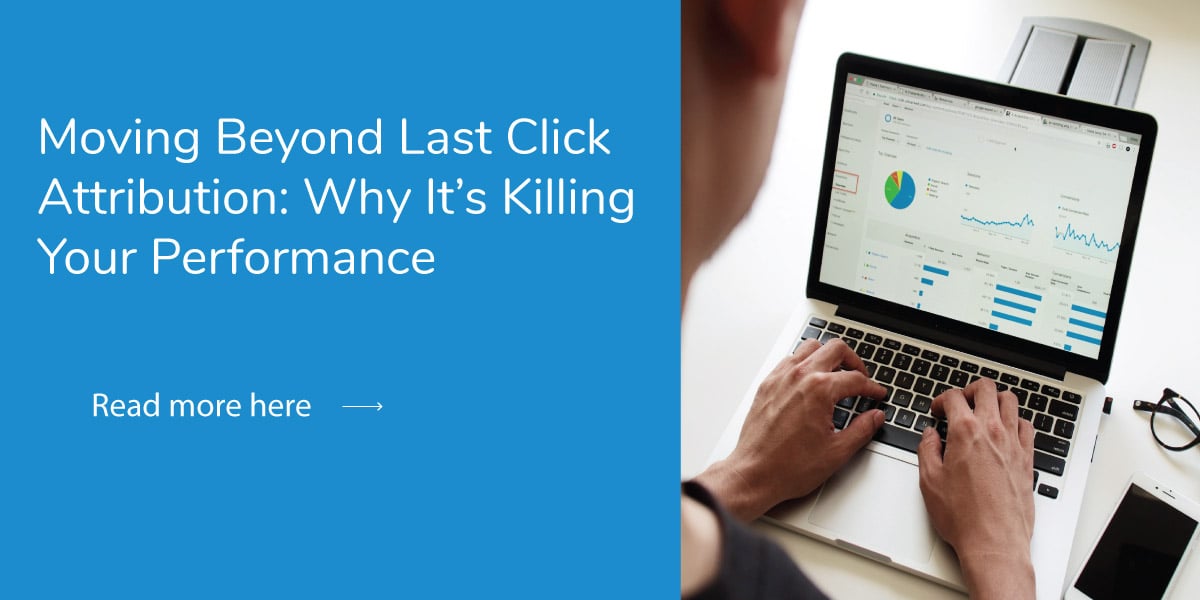Moving Beyond Last Click Attribution: Why It's Killing Performance
July 2, 2020 •Cole Geitner

Before getting on my soapbox and telling you why you should start using a data driven multi-touch attribution model, let me first start by saying Last Click Attribution is not inherently bad. In fact, there are many cases where a Last Click Attribution model can help inform where you should be spending dollars to achieve certain marketing goals/KPIs. However, there are even more cases that using a Last Click Attribution Model is bottlenecking your performance and lying to you. Now, let’s set the stage for when not to use it.
What is a Last Click Attribution Model?
Last click attribution is far and away the most commonly used attribution model. It is also the most traditional and simple attribution model. In a Last Click Attribution Model, all of the conversion’s credit will be given to the last touchpoint before the conversion is completed. In other words, if somebody visits your site 5 times through 5 different marketing channels, whichever was most recent will receive 100% of the credit.
What Attribution Model does Google Ads Use?
By default, Google Ads uses a last touch attribution model for all of your campaigns. Without knowing where to go, it can be tough to figure out how to move off of Last Click attribution in Google Ads. That is why many campaigns may be using this attribution model type without you even realizing it.
Why is Last Click Attribution Bad for Performance?
In short, Last Click Attribution is hiding information from you and that is affecting your performance. Let’s look at a few examples of how last click attribution does not show you the whole story of your marketing performance.
- Last click attribution inherently favors direct visits. Google knows this as well, as one of their common attribution models is “last non-direct click”. Think about your own internet behavior. If you are selling running shoes, a potential customer may visit a paid search ad when searching “best running shoes”, then later they’ll follow you on Facebook to learn more about your business. After seeing your posts after some time, they will just enter your site directly to finally purchase. In a last click model, neither the Paid Search nor the Organic Social touchpoint will get any credit. On the surface, it looks like they already knew your brand, but with the flowchart below that is certainly not necessarily the case.

- As a paid search marketer, for the sake of example, your job is to optimize your campaigns to get somebody to convert as quickly as possible from paid search. Even if you see a conversion come through a paid search last touch in Google Ads, that does not mean that conversion was as efficient as it could be. Although the last touch was Paid Search, so was every other touch. By not seeing the entire consumer journey through your site to purchase, you are not able to see that it took about 4x the budget to convert a customer that looks as though it converted normally. With this information, you would know to optimize your landing pages or campaigns to convert with fewer visits.

What Attribution Model Should You Use?
There will never be a single attribution model that will answer all of your questions. However, by adopting a data driven, multi-touch attribution model you are ensuring you are looking at every touchpoint along the consumers’ journeys and can allocate budget accordingly.
With DemandJump’s robust attribution solution, you can compare every single-touch and multi-touch attribution model side by side to understand the nuanced differences between them. We have even included our own data driven attribution model that uses advanced probability algorithms to understand what channels should be receiving what amount of credit. Want to see it in action? Get a demo or free assessment today!
Featured Articles
Categories
- Attribution Tracking (13)
- Channel Optimization (11)
- Consumer Insights (68)
- Content Marketing (251)
- Data Science (8)
- Digital Marketing (6)
- Digital Transformation (26)
- Enterprise (10)
- Lead Generation (14)
- Market Intelligence (8)
- Marketing Analytics (39)
- Marketing Attribution (57)
- Marketing Management (153)
- Marketing Operations (86)
- Organic Search (222)
- Paid Search (52)
- Pillar-Based Marketing (63)
- Programmatic Advertising (9)
- SaaS Content (14)
- SaaS Marketing (29)
- Search Marketing (111)
- SEO Keyword Research (28)
- SEO Pillar (18)
- SEO Strategy (46)
- SMB (5)
- Website Content (12)

